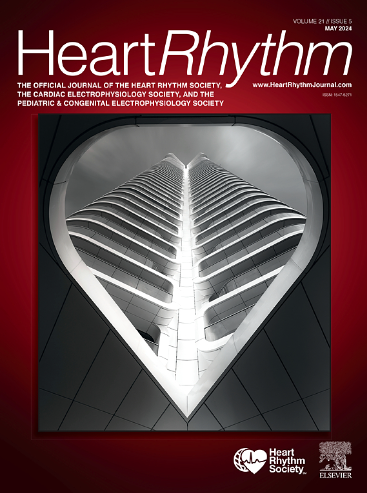Osimertinib induces prolongation of action potential duration via downregulation of KCNN1 expression: Exploring the potential mechanisms of arrhythmia
IF 5.7
2区 医学
Q1 CARDIAC & CARDIOVASCULAR SYSTEMS
引用次数: 0
Abstract
Background
Compared with earlier generations of epidermal growth factor receptor–tyrosine kinase inhibitors, the third-generation agent osimertinib demonstrates superior efficacy in patients with non–small cell lung cancer and has become the first-line treatment, but is associated with more pronounced cardiotoxicity, especially arrhythmia.
Objective
This study aimed to investigate the underlying mechanisms of the potential proarrhythmic effects of osimertinib.
Methods
We investigated osimertinib’s effects on cell viability, structure, and electrophysiological properties of human induced pluripotent stem cell–derived cardiomyocytes using cell viability assays, immunofluorescence staining, transmission electron microscopy, and optical mapping. A zebrafish in vivo model was used to validate cardiotoxicity. Western blotting (WB) assessed relative protein expression on cardiomyocyte membranes, whereas RNA sequencing and quantitative reverse transcription polymerase chain reaction identified significantly altered signaling pathways and target genes. Rescue experiments were conducted to confirm the pathogenic mechanism.
Results
The cell viability assay indicated that osimertinib reduced human induced pluripotent stem cell–derived cardiomyocyte viability (half-maximal inhibitory concentration = 3.492 μM). At this osimertinib concentration, immunofluorescence revealed disorganized myofilament sarcomeres, and transmission electron microscopy showed increased mitochondrial damage, whereas optical mapping demonstrated prolonged action potential duration and elevated incidence of early afterdepolarizations even at a near-physiological concentration. In vivo studies demonstrated that osimertinib-exposed zebrafish exhibited bradycardia, pericardial edema, and prolonged QT interval. WB revealed no significant changes in the expression of epidermal growth factor receptor. RNA sequencing revealed significant downregulation of potassium ion channel genes, with quantitative reverse transcription polymerase chain reaction and WB analysis demonstrating the most pronounced decrease in potassium calcium-activated channel subfamily N member 1 (KCNN1) expression. Modulating KCNN1 expression can reverse the electrophysiological alterations.
Conclusion
Osimertinib prolongs action potential duration and promotes arrhythmias through off-target inhibition of KCNN1 expression.

奥西替尼通过下调KCNN1表达诱导动作电位持续时间延长:探讨心律失常的潜在机制。
背景:与前几代表皮生长因子受体酪氨酸激酶抑制剂(EGFR-TKIs)相比,第三代药物奥希替尼在非小细胞肺癌患者中显示出更优的疗效,并已成为一线治疗药物,但与更明显的心脏毒性相关,尤其是心律失常。目的:探讨奥西替尼致心律失常的潜在作用机制。方法:采用细胞活力测定、免疫荧光染色、透射电镜和光学定位等方法,研究了奥西替尼对人诱导多能干细胞源性心肌细胞(hiPSC-CMs)细胞活力、结构和电生理特性的影响。采用斑马鱼体内模型验证心脏毒性。Western blotting (WB)评估了心肌细胞膜上的相关蛋白表达,而RNA-seq和qRT-PCR鉴定了显著改变的信号通路和靶基因。通过抢救实验证实其致病机制。结果:细胞活力测定显示,奥西替尼降低hiPSC-CMs细胞活力(IC50 = 3.492 μM)。在这个浓度的奥西替尼下,免疫荧光显示肌丝肌瘤紊乱,透射电镜显示线粒体损伤增加。而光学成像显示,即使在接近生理浓度时,动作电位持续时间(APD)延长,早期后去极化(EADs)发生率升高。体内研究表明,暴露于奥西替尼的斑马鱼表现出心动过缓、心包水肿和QT间期延长。WB显示EGFR表达无明显变化。RNA-seq显示钾离子通道基因显著下调,qRT-PCR和WB分析显示KCNN1表达最明显。调节KCNN1的表达可以逆转电生理改变。结论:奥西替尼通过脱靶抑制KCNN1表达延长APD,促进心律失常。
本文章由计算机程序翻译,如有差异,请以英文原文为准。
求助全文
约1分钟内获得全文
求助全文
来源期刊

Heart rhythm
医学-心血管系统
CiteScore
10.50
自引率
5.50%
发文量
1465
审稿时长
24 days
期刊介绍:
HeartRhythm, the official Journal of the Heart Rhythm Society and the Cardiac Electrophysiology Society, is a unique journal for fundamental discovery and clinical applicability.
HeartRhythm integrates the entire cardiac electrophysiology (EP) community from basic and clinical academic researchers, private practitioners, engineers, allied professionals, industry, and trainees, all of whom are vital and interdependent members of our EP community.
The Heart Rhythm Society is the international leader in science, education, and advocacy for cardiac arrhythmia professionals and patients, and the primary information resource on heart rhythm disorders. Its mission is to improve the care of patients by promoting research, education, and optimal health care policies and standards.
 求助内容:
求助内容: 应助结果提醒方式:
应助结果提醒方式:


